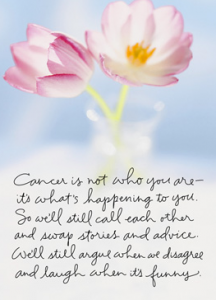Every year, Americans buy close to 7 billion cards to wish someone happy birthday, bon voyage, or any other number of congratulatory and sympathetic messages. And by 2014, Hallmark plans to launch one of their most ambitious collections yet: a series of cards for when someone is dying from a terminal illness. It’s an exciting venture — and one that I hope will work to de-stigmatize the Western notion of death as a taboo, under-the-rug topic. You could argue that the act of purchasing a greeting card — instead of simply telling the recipient an original message – shows an inability to confront death and sentimentality; it shows that the intent to communicate exists is there, but that there’s something debilitating about it.
So what can we infer about the collective American psyche in regards to the new collection — and specifically, in regards to how it handles death?
Hopefully, the advent of the “Terminal Illness” line is telling of a more positive, open approach to death and dying in the United States. “America is rediscovering death,” says The Economist in a recent article about the new collection; “Editors and art directors at Hallmark’s headquarters in Missouri say that customers now want candour, even about terminal illness” when someone is dying.
Even if Americans aren’t writing the messages themselves, at least they’re acknowledging the need for cards that will, at the very least, catalyze the discussion on death and dying to a new level.
There has also been a change in traditional “Sympathy” card imagery over the past few years. Colorful, playful images have been occurring in lieu of more formal, reserved images (think muted lilies and soft clouds). The result? Collections that examine death in a positive and unabashed light; collections that embrace the reality of death, but don’t view death as something that should necessarily incite sadness or emotional austerity. “Empathy is in,” explains The Economist; “Formality is out.”
“You’re in some of the best memories I have and you always will be,” reads one of the cards from the upcoming collection. It doesn’t ignore the presence of a terminal illness in someone’s life, yet the collection manages to communicate a sense of optimism. The card acknowledges the terminal nature of the illness, but doesn’t just indulge in sheer solemnity–rather, it highlights the shared moments between the card-giver and recipient that will endure beyond death.
Related articles:
- http://www.economist.com/news/united-states/21580157-hallmark-cards-show-new-candour-about-terminal-sickness-american-way-death
- More Than a Hallmark Holiday: Rooted in Catholic and Ancient Roman tradition, the history of Valentine’s Day is fraught with love, death and trial
- Greeting cards for the terminally ill are a great idea: Hallmark introduces a new line to deal with tough topics — and that’s a good thing

 Hallmark Announces Cards for Terminal Illnesses
Hallmark Announces Cards for Terminal Illnesses




 “Other Side” Documentary Directed by Carter Oakley and Heather Hogan
“Other Side” Documentary Directed by Carter Oakley and Heather Hogan
















